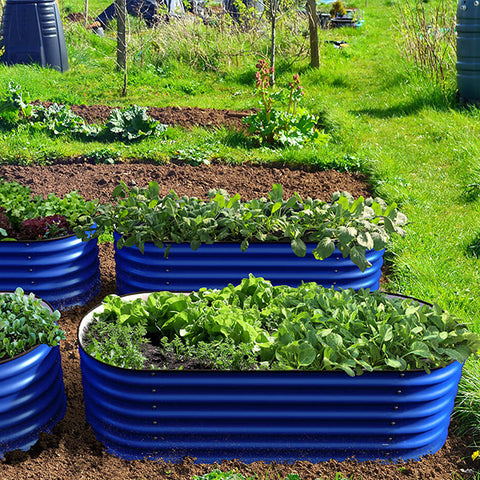5 Tips for Planting Your Favorite Plants on a Raised Garden Bed
Don't have enough space to plant your favorite plants? Managing your garden becoming a challenging task? Utilizing raised garden beds can bring your lush garden to life. Here are some conservative secrets to successful gardening with raised garden beds!

Imagine waking up and seeing delightful flowers in front of your house, or preparing delicious meals with vegetables from your backyard kitchen garden! Sounds lovely, right? If you're a gardening enthusiast, you've probably been nurturing these dreams for a long time! However, some of us may find it challenging to achieve these dreams due to limited space.
Worry no more! You can now realize your dreams even with limited available space. All you need is one (or several!) garden beds. These container gardens are filled with lightweight, nutrient-rich soil that can produce twice the yield in half the space. They are also easier to maintain, being elevated and enclosed – no tilling or bending to pull out weeds.
Metal raised garden beds are often more productive than ground beds, as the soil is less compacted, drainage is better, and they warm up earlier in the season, allowing plants to start growing earlier. Garden beds can also be easier to manage, especially for those with limited mobility, and generally have less weed pressure. In this article, you will find some amazing ideas for planting your favorite plants all year round. So, keep reading!
Seek the Perfect Materials and Design
Materials matter! The best raised garden beds are made from waterproof and rot-resistant materials. So, if you want a perfect garden, make sure it's constructed using concrete blocks, retaining wall blocks, landscape blocks, or landscape timber/exterior-grade wood (such as redwood, cedar, and black locust). However, the best choice is always metal raised garden beds. Also, ensure your garden bed has the perfect soil mix for the plants you wish to grow.
Better yet, find the best gardening company in your area and order the perfect garden beds and soil mix for your garden. This way, you won't have to worry, and you can focus on other important things. Like taking care of your plants.
Pay Attention to Spacing
Apart from planning the design, materials, and size of the garden beds, also consider the width of the beds. Make sure they are not too wide. You should be able to reach each plant easily without overbalancing or stretching too much.
You should also pay attention to the distance between each plant and its neighbors. Don't overcrowd them. Ideal spacing allows a wheelbarrow to pass through the path between two plants. This is useful to remember during sowing. It also comes in handy when placing mulch or weeding.
Use Mulch
The lightweight, nutrient-rich soil in raised garden beds is an ideal choice for root growth. However, if left unprotected from harsh elements, it tends to dry out.
Mulch - a long string of organic materials like shredded dry leaves, hardwood chips, grass clippings, straw, or sawdust - should be applied on the soil to keep it cool and reduce evaporation while suppressing the growth of weed seeds. You can also buy bagged commercial mulch from a good gardening store. Spread the mulch in an even two-inch layer and gently push it down for best results.
Also, try planting cover crops after each growing season to enhance soil fertility. These could be deep-red clover, annual ryegrass, hairy vetch, etc. They will add more nutrients to your soil and protect it from harsh winter conditions. Come spring, dig them into the raised bed soil, turning them into mulch.
Don't Skip Compost
While mulch is an excellent element for protecting and enhancing garden soil, compost is a must-have for raised garden beds. If you want your plants and vegetables to be in top condition, don't forget to dress the garden beds with about two inches of compost (preferably organic compost) during the first planting of vegetables. Mid-season, when you pull out the spring harvest, reapply compost again. This helps to replenish nutrients in the soil and maintain fertility.
Use Quick-Connect Garden Hoses
Quick-connect intermittent nozzles can save you a lot of time in the garden and make watering more effortless. No more wasting time and effort trying to thread the nozzle or sprinkler correctly onto the hose.
Water your garden plants from the ground up, not from above using a sprayer or sprinkler. Watering from above can wet the leaves, which may increase the risk of fungal diseases. For instance, septoria leaf spot, which can wipe out an entire crop. Consider gently winding a soaking hose around the base of your plants. You may also consider using a drip irrigation system. Do you know when is the best time to water your garden beds? Find out the answer here.
Traditional ground beds are great, but with raised garden beds, you can practically work wonders with minimal effort. It allows you to grow more plants in less space, customizes the garden soil more effectively, and prevents weeds from spreading excessively. Additionally, garden beds make harvesting and preparing the soil for the next season much easier. It enables you to do gardening without contending with roots and rocks, with no need for tilling, and even prepares the soil faster for planting.
As you can see, the advantages of raised garden beds are truly endless. So, what are you waiting for? Get ready to plant vegetables and flowers all summer long! Just follow these simple tips, and you'll see your garden blooming and blushing without any extra effort.
If you still find this task challenging, don't shy away from consulting gardening services. But, please ensure they are the right choice before resetting your gardening professional to zero. To confirm, check if they are experienced, have good reviews, provide after-sales support, and most importantly, use digital tools like field service management software and mobile apps in their operations.

